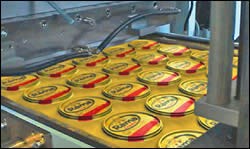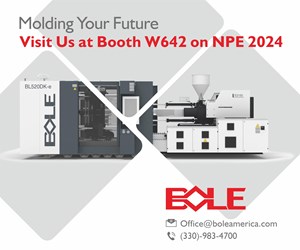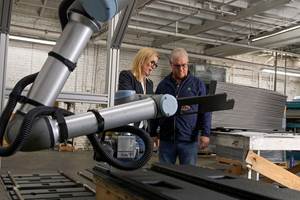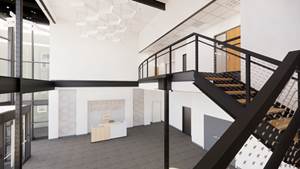NPE 2006 News Wrap-Up: Thermoforming
Several new processing technologies unveiled at NPE point to thermoforming’s growing capability to produce in-mold labeled and decorated plastic parts.
Several new processing technologies unveiled at NPE point to thermoforming’s growing capability to produce in-mold labeled and decorated plastic parts. One new vacuum-forming method produces paint-free automotive parts from extruded TPO sheet with a paint-film lamination. Another innovative system doubles the output of PP dairy lids made from preprinted sheet. And in-mold labeling (IML) is taking a step forward by incorporating RFID tags to create “intelligent packaging.”
Meanwhile, in cut-sheet thermoforming, new rotary equipment at the show was claimed to set a new benchmark for throughput of HIPS and ABS refrigerator door and cabinet liners.
Going paintless
Geiss Thermoforming showed off its latest effort in so-called Thick Sheet Forming (TSF), which involves laminating a decorative film or material onto a heavy-gauge (3-6 mm) sheet for subsequent thermoforming directly into finished parts. The hood scoop for the 2006 Ford Mustang is made of 4-mm TPO sheet laminated with a paint film from Soliant. The TPO sheet is extruded and laminated by Southtech Plastics. TSF is a proven approach; what’s new is Geiss’s new simplified processing technique, which uses vacuum forming and a special heating system to reduce complexity and cost, according to Geiss representative John Pirkl.
Previously, such “Class-A surface” parts had to be made on higher-cost pressure formers with elaborate cooling systems. These parts were heated below 300 F in order to avoid surface degradation. But with Geiss’s T-Series cut-sheet vacuum former, TPO sheet reportedly can be heated up to 360 F thanks to the unit’s flash halogen heating system. With a short wavelength of just 1 micron, halogen heating penetrates the sheet’s core, creating “inside-out” heat. In comparison, ceramic or quartz heaters have longer wavelengths and the heat is absorbed at the surface, thus dulling the look and appearance.
Geiss says that Class-A parts can be achieved more simply and at a reduced investment, particularly in terms of machine cost. The company is in discussions with other car makers regarding similar projects.
Marbach, a German thermoform tooling specialist, continues to make strides in production of preprinted PP lids. The so-called clamp-frame technology developed by German packagers Huhtamaki/Rube and RPC Bebo Plastik together with Marbach and machine maker Gabler, reportedly has done a good job of preserving registration during PP forming. However, it has won only limited use, mostly on small machines in Europe. Now, Marbach and Gabler have boosted throughput by more than doubling the forming area. Gabler’s Varius SR roll-fed unit with Marbach’s 4P (pre-printed PP) tooling technology can now accommodate sheet widths up to 840 mm x 800 mm. The machine runs up to 36 cavities and produces 500-g margarine lids at about 50,400/hr. Typical lid thickness is about 0.4 mm.
Marbach’s tool design provides minimum web shrinkage through the use of controlled water cooling and modified tool movements to avoid sheet stretching and distortion at the formed edges, according to Hubert Kittelmann, president of Marbach Tool & Equipment Inc. in the U.S. In addition, the thermoforming machine incorporates a print-register control that aligns the sheet with the exact mold position, as well as a divided sheet transport system that smooths out wrinkles in the hot sheet. In Europe, one of the first applications utilizing the new technology will be a square margarine lid this fall.
IML + RFID
At NPE, German robotics supplier Hekuma GmbH (represented here by Electronic Media International) demonstrated its relatively new system for multi-cavity in-mold labeling of PP yogurt tubs on a Kiefel machine. Though the system has been available for at least 2 years, Hekuma has added something new, integrating its IML system with RFID technology to create packaging capable of holding supply-chain data for shipping, inventory, and freshness tracking. Hekuma says it has proven the technology with a manual system and is developing an automatic process for applying the RFID tag to the in-mold label and the cup. Two different, undisclosed adhesive coatings are used to apply the RFID tag to the label and then to the container.
The RFID tag consists of a copper printed circuit that is attached to a PET film. The 0.5-mm-thick tag is 35 mm long x 18 mm wide. Hekuma concedes that the RFID tag is currently too expensive for commercial use, costing between 15 and 20 euro cents apiece. At the show, a four-cavity IML and RFID system produced yogurt cups at 15 cycles/min.
The IML system—a collaboration between Hekuma, Kiefel, and Austrian tooling specialist Mould & Matic—was demonstrated at the K 2004 show in Dusseldorf. At NPE, Hekuma disclosed that the first commercial IML system is expected to be installed in the first quarter of 2007. It will run 10 cavities and produce rectangular food containers at 15 to 20 cycles/min.
Machinery partnerships
NPE also saw the announcement of new partnerships involving some of the industry’s leading machine suppliers. First, Sencorp Inc. has teamed up with Asano Laboratories Co. Ltd., the biggest supplier of thermoforming machines in Japan. Sencorp hopes the joint effort will expand its presence in North American food packaging by using Asano’s wide-bed thermoformers, matched-metal trim presses, and quick-response heaters, according to Sencorp president Brian Urban. Sencorp will sell Asano’s FLC roll-fed machine and PLS punch presses in the U.S. In addition, it will integrate Asano’s heaters into its Sencorp 2200 and 2500, Armac, and Gen II roll-fed thermoformers.
Asano’s “thermal band” heaters reportedly feature very high watt-density and ability to go from ambient to 500 C and then back to 200 C in a total of about 10 sec. The heater’s “instant-on” feature greatly increases machine availability, according to Sencorp. In addition, the ability to turn the ovens on and off quickly results in 20% energy savings versus standard quartz heaters.
Asano’s technology also includes a special clamp-chain web-transport system that saves an inch in material width compared with traditional pin-chain systems and also eliminates punch-out particulates. Other features include integrated robotics for sheet handling and automated systems for stacking and counting.
Meanwhile, OMV-USA is entering into a partnership with Irwin Research & Development for production of OMV in-line forming machines in the U.S. Irwin will build OMV’s large F57 system at its Yakima, Wash., site. The high-volume machine, now built in Italy, features integrated extrusion, forming, rim-rolling, stacking, and counting. With a 70-cavity tool, the F57 can run 32-oz PP containers at 60,000/hr. Extrusion capacity is up to 6000 lb/hr. Irwin will contribute its fast-moving toggle technology and experience with large-platen machines. The machines will be marketed by OMV-USA.
Since the introduction of the F57 four years ago, four systems have been sold in Europe and two in the U.S. OMV-USA president Kent Johansson hopes the U.S.-built machines will be more affordable without the costs of transatlantic shipping and import duties.
Another new development for in-line extrusion and forming is a new roller-screw design from Brown Machine for actuation of independent third-platen plug-assist motion. The patent-pending technology is claimed to provide higher stiffness, greater load capacity, and longer operation for machines using plug assist. The plug-platen system is actuated by a single roller screw driven by a servo motor. The platen is guided by eight linear bearings and incorporates quick-change cylinder locks for attachment to the plug tooling plate. An independent oil lubrication system is included for the roller screw.
Brown sources say this system’s roller screw can work at higher rpm than ball screws and service life is 15 times longer than a comparably sized ball screw.
High-speed rotary
In industrial thermoforming, a show highlight was Brown Machine’s introduction of a four-station rotary pressure former for high-speed processing of refrigerator door and cabinet liners. The new unit claims to set a new production mark of 80 to 90 liners/hr versus 70 to 75 previously.
The new machine, based on Brown’s R-Series, can apply 35 psi air pressure and boasts a special flange-cooling system. Other features include high-speed rotation and high-speed platens with variable-frequency electric drive and closed-loop control that is said to provide upper and lower platen repeatability within ±0.005 in. Besides the main oven, there is also a multi-zoned, high-watt-density preheat station. A global appliance manufacturer has switched from in-line cut-sheet equipment to the new rotary for a new facility, according to Brown.
Related Content
Cobot Creates 'Cell Manufacturing Dream' for Thermoformer
Kal Plastics deploys Universal Robot trimming cobot for a fraction of the cost and lead time of a CNC machine, cuts trimming time nearly in half and reduces late shipments to under 1% — all while improving employee safety and growth opportunities.
Read MoreSustainable Materials is Focus of Thermoforming Exhibits at K 2022
Thermoforming equipment makers including WM, Kiefel, and OMV will showcase processing of recyclable and biobased materials.
Read MoreThermoformer Maximizes Productivity with 3D Printing
Productive Plastics has created an extensive collection of 3D printed manufacturing aids that sharply reduce lead times.
Read MoreBrueckner Group USA Moving to Bigger Space
New facility in New Hampshire will serve the local customer base better and enhance capabilities in the North American market.
Read MoreRead Next
People 4.0 – How to Get Buy-In from Your Staff for Industry 4.0 Systems
Implementing a production monitoring system as the foundation of a ‘smart factory’ is about integrating people with new technology as much as it is about integrating machines and computers. Here are tips from a company that has gone through the process.
Read MoreAdvanced Recycling: Beyond Pyrolysis
Consumer-product brand owners increasingly see advanced chemical recycling as a necessary complement to mechanical recycling if they are to meet ambitious goals for a circular economy in the next decade. Dozens of technology providers are developing new technologies to overcome the limitations of existing pyrolysis methods and to commercialize various alternative approaches to chemical recycling of plastics.
Read More


















.png;maxWidth=300;quality=90)










